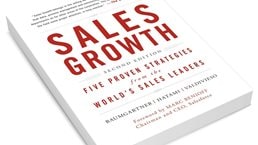B2B sales are on the verge of a revolution, with a number of trends completely redefining what it will take to be a market leader over the next five years.
Stay current on your favorite topics
Advanced analytics and machine learning have given sales executives access to historically unprecedented amounts of data and computing power, allowing them to predict with a high degree of precision the most valuable sales opportunities. The fastest-growing companies are using advanced analytics to radically improve their sales productivity and drive double-digit sales growth with minimal additions in their sales teams and cost base.
Also, radical changes in buyers’ preferences, with buyers being more content-driven, technically savvy, and comfortable engaging via digital channels, has led to the rise of a new breed of sales leaders who bring technical expertise and a strategic mind-set. This is also transforming what sales organizations look like, with a sharp reduction in field sales and marketing, and rapid growth in inside sales and analytics teams.
Finally, a significant shift toward subscription-based business models has redefined how customer relationships are managed. No longer is a sale a one-time “won and done” deal. In a world of recurring revenues, sales need to be won every month, quarter, and year. As a result, successful customer-relationship managers are becoming increasingly more valuable, and sophisticated sales teams are aligning themselves closely to the long-term success of their customers.
Emergence of a new science of B2B sales
As a result of these disruptive changes, B2B sales has evolved from an art to a science. By that we mean that sales is data-driven, enabled by digital tools, underpinned by advanced analytics, and focused on really understanding the “what, why, and when” of the customer. Companies that have embraced what we call the “science of B2B sales” have already started to pull ahead of their peers in terms of revenue growth (registering 2.3 times industry average revenue growth), profitability (3 to 5 percent additional return on sales) and shareholder value (8 percent higher total return to shareholders than the industry average).
A key feature distinguishing market leaders from the rest of the pack is that the CEOs of the market leaders actively lead the sales transformation, rather than leaving it to the head of sales. These CEOs realize that redefining their go-to-market engine is a cross-functional sport that requires their direct engagement and flawless execution from sales, marketing, HR, IT, and finance. Market leaders have realized that winning in B2B sales in the next five to ten years will require them to fundamentally transform their go-to-market engine around three defining principles:
1. Engaging customers the way they want to be engaged
Days when sales executives debated between investing in a great sales force or great digital assets are a figment of the past. Driving growth in the future will require bringing the best of both worlds. Our research indicates that market leaders view digital investments as the glue that holds together a powerful multichannel sales strategy. We surveyed more than 1,000 large organizations across industries and four continents to better understand their preferences in buying goods and services from B2B sellers. Our research showed that the ideal channel to reach B2B customers depends heavily on whether they are making a first-time or repeat purchase (Exhibit 1). Some 76 percent of B2B buyers found it helpful to speak to a salesperson when researching a new product or service. That figure fell to 52 percent for repeat purchases of products with new or different specifications, and only 15 percent indicated a desire to speak with a salesperson when repurchasing exactly the same product or service.

Engaging customers in the future will require a multichannel sales strategy powered by smart digital investments, which caters to the different needs of first-time and repeat customers.
When targeting first-time customers who are looking for direct interaction with sales teams, the fastest-growing companies are using digital tools to help their sales teams address customer needs at each stage of their purchase journey. For instance, they are using interactive product demos powered through tablets or browsers to help salespeople engage customers in the research stage of their journey. A significant proportion are using relatively simple customer-relationship-management software to track customers’ past questions, thus allowing their salespeople to anticipate future inquiries and offer lightning-fast responses when customers compare their products with competitors’. A few cutting-edge companies have also invested in customer analytics that empower sales reps with price recommendations based on analysis of deals other sales reps have closed with the same customer in the recent past.
Would you like to learn more about our Marketing & Sales Practice?
When catering to repeat customers who are comfortable being online, the fastest-growing companies are using digital tools and inside sales to keep them loyal, speed up the sale process, and encourage them to spend more. For instance, they are creating online comparison engines that allow customers to seamlessly compare products and services with competitors’ offerings. They then supplement that with inside sales teams to answer customer questions via email, live chat, and video conferencing. In addition, they are using next-product-to-buy algorithms that send customers relevant recommendations of complementary products based on their purchase history to grow customer share of wallet.
2. Using advanced analytics and machine learning to make better decisions faster
In the next five years, we believe that the fastest-growing companies will be using advanced analytics and machine learning to address fundamental strategic issues, such as what sales opportunities to pursue, what resources to allocate to which accounts, and what behaviors to prioritize to drive sales productivity. Already the days when lead generation relied entirely on local field knowledge are fading fast. Market leaders of the future are using advanced analytics to build a granular account, product, and geographic profile of each of their customers. These profiles are then augmented with relevant external data such as news reports, public financial information, and social media to generate a truly 360-degree view of each customer.
Lead-scoring algorithms can then use these detailed customer profiles to predict which customers to target, when to contact them, and what factors truly drive lead conversion rates. A few of the most cutting-edge companies are also experimenting with AI-enabled agents that use predictive analytics and natural-language processing to automate early lead-generation activities such as handling basic customer questions and automating initial presales questions. While these predictive lead-scoring algorithms are still relatively nascent, some companies deploying them are already experiencing 15 to 20 percent improvement in their lead-conversion rates.
In the past, sales leaders used to rely on gut instinct to identify behaviors that drive sales productivity and make account coverage decisions. Advanced analytics is revolutionizing our understanding of how to match the right people to the right deals. The most data-savvy sales organizations are combining sales, customer, and HR data to understand the intrinsic attributes (e.g., professional background, education, personality traits, cognitive ability) and behaviors (e.g., frequency/duration of customer interaction, time devoted to sales planning, listening skills, persistence, risk taking) that are statistically correlated with distinctive sales performance. Armed with this knowledge, they can identify the best sales people and allocate them to their most strategically valuable accounts.

Sales Growth: Five Proven Strategies from the World’s Sales Leaders (2nd edition)
3. Continually investing in finding and developing world-class talent
Buyers are becoming increasingly sophisticated and technically savvy, which has led to the rise of a new breed of sales leaders who bring a strategic mind-set and rock-solid technical skills. These leaders are “growing up” across multiple roles in their organization and come with a truly cross-functional and cross-geographic skill set. They view themselves as coaches whose primary job is to turn rookies into rainmakers.
“Getting the right individual in the right role” was a common theme that came up in our survey of 1,000 sales executives. Despite the stated importance of hiring the right talent, not all organizations believe they are equipped with the right talent for the future (Exhibit 2). While all companies struggle with getting world-class talent, fast-growth companies fare better than slow-growth companies: 51 percent of the former believe they have the right sales talent for the future compared with only 30 percent of slow growth companies.

Hiring the right talent is only part of the puzzle. The fastest-growing companies also invest significant time and resources in nurturing and growing their talent. In our survey, 48 percent of fast-growth companies indicated that they invest significant time and resources in sales training versus only 22 percent of slow-growth companies (Exhibit 3). Behavioral economics and social psychology have revealed powerful insights into how to nurture high-performing individuals who thrive on independence and entrepreneurship. A defining insight has been that adult learners only remember 10 percent of what they heard and 32 percent of what they saw three months after the learning program concludes. In contrast, they remember 65 percent of what they learn by doing. This insight is driving a transformative change in the nature of sales trainings. They are evolving from classroom and digital modules to “on-the-job” experiential, immersive programs in which sales reps are paired with experienced coaches and learn from doing.

How to embrace the science of B2B sales
Companies who embrace the science of B2B sales generally begin with a three-part journey:
First, they make an honest assessment of the status quo. This starts with a look at the customer. Customer preferences for buying should shape the investments the sales organization makes, yet many sales leaders fly blind. In our experience, most companies tend to underinvest in the sales capabilities that actually matter most to their customers.
Second, they plan for the long term. Sales winners are moving past quarterly planning and adopting instead a long- term view. Of the fast growers we have studied, more than 50 percent take a minimum 12-month view in their sales plans, and 10 percent look more than three years out. This long-term view means that sales leaders can invest in the right capabilities based on a specific (though flexible) roadmap.
Third, they move fast and get quick wins. Speed matters now more than ever. Winning sales organizations are using test-and-learn strategies to become more nimble. Some set up a sales war-room model to launch new digital campaigns and messages. Others adopt an agile test-fail-learn-adapt operating model to rapidly ideate and refine sales tactics. Through these quick-win approaches, sales orgs are seeing dramatic results, some with up to 300 percent growth in digital sales within the first 30 days of action. In the next few years, we expect to see more of the winners enjoying these results.
Driving market leadership in B2B sales takes undivided focus from the CEO and his/her top team, and significant investment of time and resources. However, companies that have achieved proficiency across the three dimensions of the science of B2B sales are already outpacing their competitors and driving disproportionate growth, profitability, and shareholder value.


